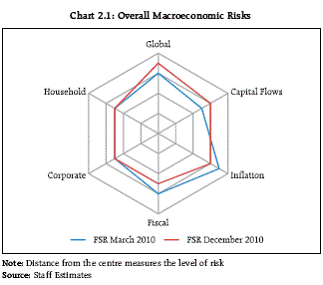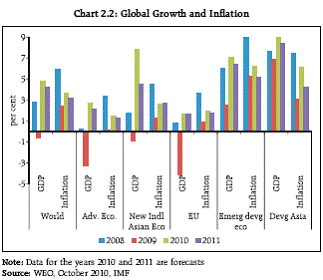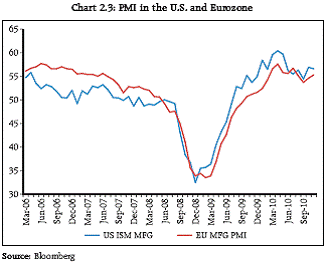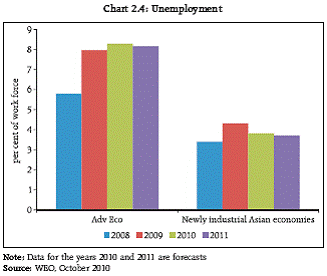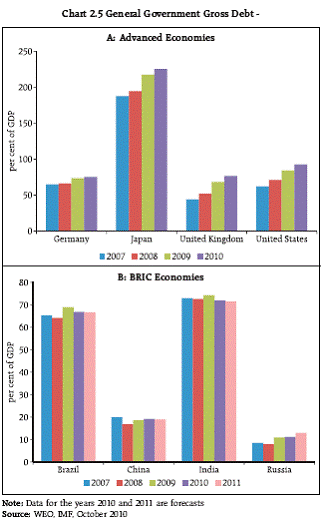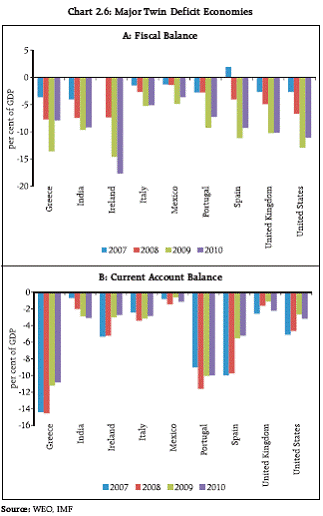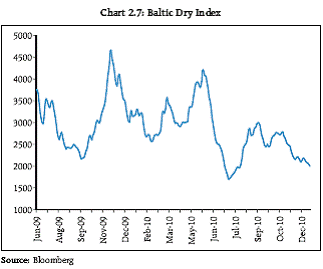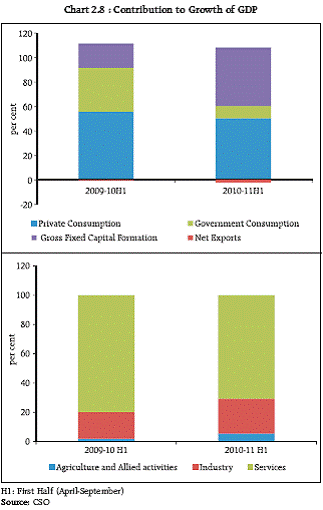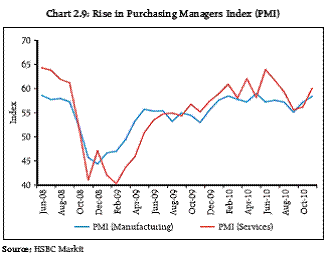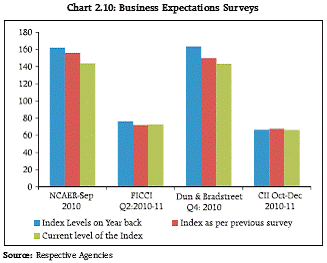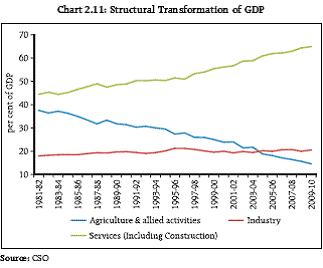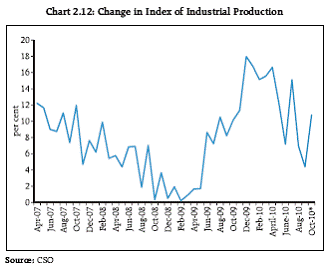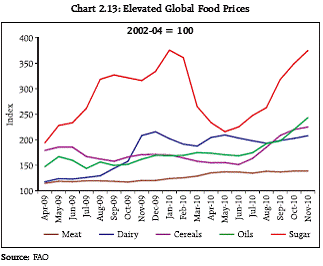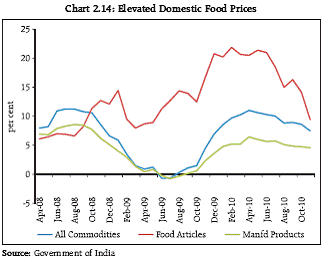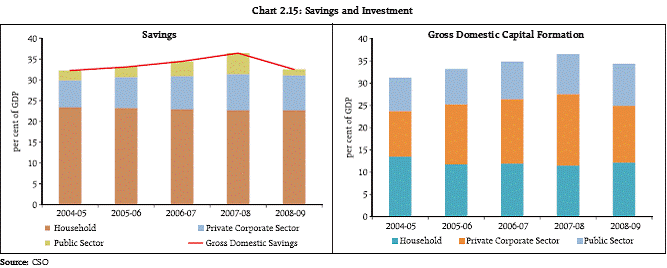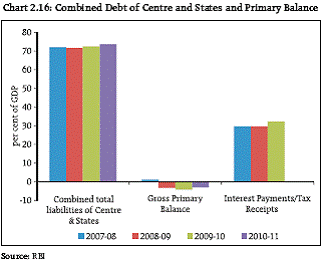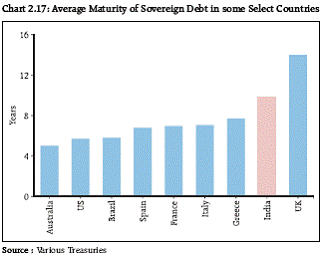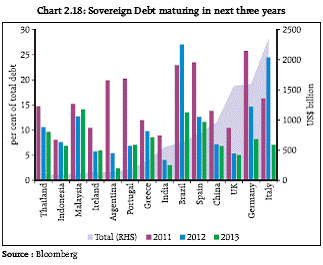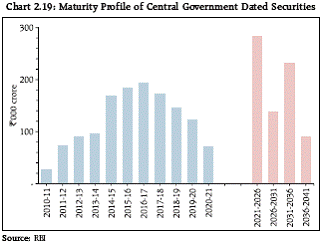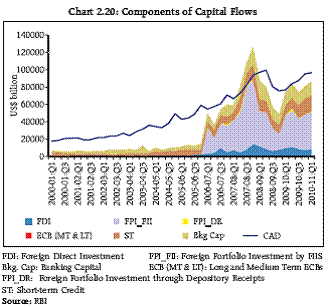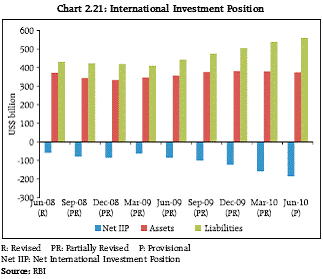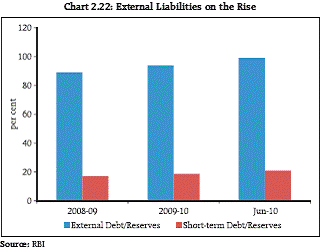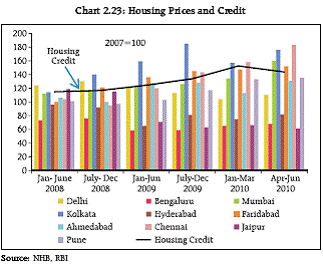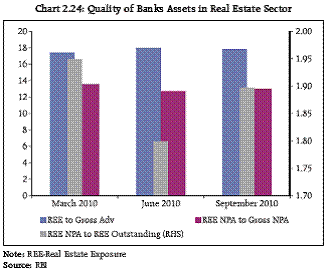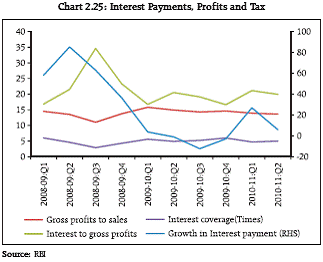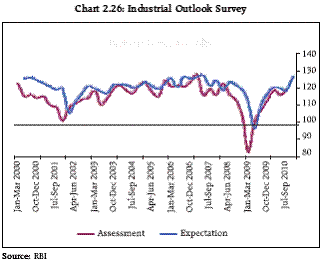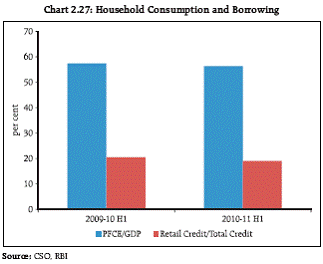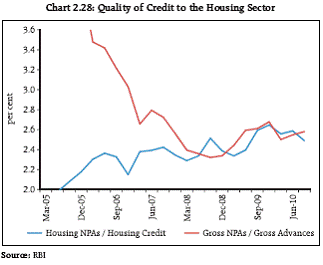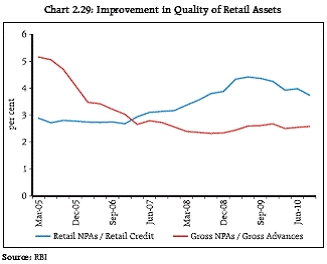 IST,
IST,
Chapter II : Macroeconomic Environment
The global economy is recovering from the crisis but some existing concerns remain and new concerns have emerged. Several advanced and other economies suffer from slow growth and high sovereign debt. Some measures taken by advanced economies like large interest rate cuts, maintenance of near-zero rates and injections of liquidity are leading to large capital inflows to emerging market economies (EMEs) and to higher commodity prices. The full recovery of trade as well as confidence at the global level is contingent upon recovery of all economies, particularly the advanced economies. Business cycle synchronisation of the Indian economy with most of the advanced economies and EMEs has increased over time. Thus, deterioration of global risks, uneven recovery in growth and employment, elevated commodity, particularly food prices, and global imbalances have a stronger impact on India than before. On the domestic front, a large share of volatile components in financing of current account deficit (CAD), limited fiscal manoeuvrability and a sharp rise in asset prices too have implications for financial stability. The performance of retail credit has improved but the rise in asset prices, particularly that of housing, is emerging as a concern. Role of Macroeconomic Risks 2.1 Macroeconomic risks affect financial stability through multifarious channels. The outlook for growth and employment at the global and domestic levels impact the ability of debtors to pay back borrowed funds and perceptions of credit risk. Inflation/deflation risks determine real debt burdens and impact fixed income markets. Fluctuations in asset prices impact the value of collaterals and the ability of debtors to meet their obligations. Macroeconomic imbalances or shocks and unsustainable fiscal and external debt burdens provide fertile ground for triggering disruption of the financial system. The process of economic rebalancing too has implications for the financial system. During internal rebalancing, fiscal consolidation needs to be accompanied by enhancement of private demand through larger and cheaper flow of credit. On the other hand, during external rebalancing, many advanced countries may have to increase their reliance on net exports while several EMEs have to enhance their dependence on domestic demand. This entails, among others, some readjustment of the exchange rates and reorientation of the financial system. Overall Macroeconomic Risk Scenario in India – Comparative Position 2.2 As compared to our previous assessment in the first Financial Stability Report (FSR) published in March 2010, there has been deterioration in global and capital flows risks. Both household and corporate sectors continue to remain healthy and their risk levels remain unchanged. Inflation risks have abated, although they still remain high. Fiscal conditions too, though stretched, have improved with initiation of consolidation measures (Chart 2.1)
Global Developments Global Risks Worsen 2.3 Business cycle synchronisation (in terms of GDP) of the Indian economy with most of the advanced and EMEs has increased over time, particularly during recent periods,1 thereby enhancing the influence of global developments. The Global Financial Stability Report (IMF, October 2010) highlights increases in risks to financial stability as compared to its assessment in April 2010. Aggravation of sovereign debt and deflation concerns contributed to increase in macroeconomic risks. Risks associated with banking sector also went up during this period. However, due to stronger corporate sector, the overall credit risks remained unchanged. Risks associated with emerging markets recorded some improvement due to strong fundamentals and better growth outlook. Global Growth is uneven and uncertain … 2.4 The IMF has projected that the current calendar year may witness a global recovery followed by modest deceleration in the following year (Chart 2.2). Data on Purchase Managers Indices (PMIs) for manufacturing in the U.S. and Eurozone though above 50, are currently lower than the peak of 60 reached in April 2010, thereby indicating possible prolongation of slow growth (Chart 2.3).
2.5 Rebalancing in favour of domestic economies by some countries may inhibit full recovery of world trade. In the U.S., a major trading partner of India, while there is a positive push with the liquidation of inventories, persistence of high unemployment, low growth in consumer spending and dormant housing sector point towards prolonged recovery. Further, the current deleveraging is expected to be a protracted process. And as Japan has experienced, these are difficult conditions to offset with monetary and fiscal policies. … Unemployment remains high among advanced economies 2.6 High unemployment among advanced economies is a concern as it is expected to a have a more persistent impact on global demand (Chart 2.4). Structural employment may take longer to reach its pre- crisis levels and may drag down productivity over the medium-term.
Sovereign debt high and resolution to be prolonged 2.7 The sovereign debt crisis has made the link between debt management and financial stability more explicit suggesting the need for closer coordination with fiscal, monetary and financial stability authorities. It is well recognised that government debt cannot grow on a sustained basis well above the growth rate of nominal GDP without causing severe disruptions to the overall economic system. The large share of fiscal resources needed to service higher public debt might crowd out productive expenditures and could also lead to higher distortionary taxation. In the long run, persistently high debt makes economies more vulnerable to adverse shocks, reduces their long-run growth potential and impacts monetary and financial stability. High levels of public debt also tend to undermine the credibility of monetary policy. The sovereign debt crisis and its management provides useful experiences and lessons (Box 2.1). Box 2.1: Sovereign Debt Crisis The macroeconomic imbalances and structural weaknesses of the Greek economy surfaced under the pressure of the economic and financial crisis characterised by large fiscal deficit, enormous public debt and consistently eroding competitive position manifested in a gradually deteriorating current account balance. Large holdings of sovereign debt paper with European banks sparked off systemic concerns. Similar concerns in other EU economies namely Portugal, Ireland, Italy and Spain added to these concerns. Heavy selling of the sovereign debt of vulnerable euro area economies took a toll on their banking system. This caused a significant depreciation of the euro and a broader decline in stock prices in the Euro zone but also transmitted volatility to other financial markets across the world. Risk premiums on corporate bonds widened, and corporate bond issuances slowed to a trickle in May. Issuance in emerging markets also dropped sharply. To assist Greece, on May 2, 2010, Euro Area and IMF pledged US$145 billion in bilateral loans and Stand-by arrangement. Subsequently, the Economic and Financial (Eco-Fin) Council of the European Union (EU) announced stabilisation measures on May 10, 2010. These measures included creation of a European Stabilisation Mechanism (ESM) which incorporates strong conditionality and has two components: (i) the first permits the European Commission to provide up to €60 billion (US $ 79 billion) balance of payments facility for Euro zone members that are facing a severe deterioration in borrowing conditions due to factors beyond their control. This will carry IMF conditionality and will be financed by the issuance of EU bonds; and (ii) the second is a voluntary intergovernmental agreement of Member States to compliment the Commission resources through a Special Purpose Vehicle (SPV) called European Financial Stability Fund (EFSF) and worth up to €440 billion (US$ 580 billion) over a period of three years. The IMF decided to participate in the financing arrangements and would provide at least half of the funding requirements. This would be guaranteed proportionately by participating Euro zone members, and also subject to strong conditionality. In parallel with the announcement of the ESM, the European Central Bank took action to stabilise euro area sovereign debt markets through sterilised purchases of sovereign debt of certain countries. The ECB announced security markets programme with interventions in both public and private debt securities markets. The G7 also announced the reactivation of bilateral dollar swap lines between the Federal Reserve and ECB, Bank of England and SNB. Temporary swap facilities with the US Federal Reserve were reactivated using ECB-eligible collateral. European policy initiatives and frontloading of fiscal adjustment, led to reduction in tail risks and improvement in financial conditions. However, underlying sovereign and banking vulnerabilities remain a significant challenge amid lingering concerns about risks to the global recovery. Even as the Greek crisis was going into the backburner, the Irish debt situation has surfaced. Recently the Irish government declared that its recapitalisation commitment to its banking system was going to be higher than previously estimated (from €33 billion to €46 billion i.e. from 20 per cent to 28 per cent of GDP). This immediately raised concerns for the sustainability of Ireland’s sovereign debt. The Irish government has stated that its funding needs until mid-2011 are met and initially resisted accepting bailout funds. The Credit Default Swaps on its sovereign debt have risen manifold while the market for its debt is virtually shut. Prior to the crisis, the Irish fiscal situation was very sound. Low corporate taxes, and interest rates (owing to introduction of Euro) have fuelled a bank finance led housing and commercial real estate boom. Taxes associated with asset booms like estate and capital gains tax became a large component and eventually evaporated when the cycle turned during the crisis. In monetary unions like the euro system member countries pursue independent fiscal policies but do not have recourse to exchange rate or monetary policy levers to make the adjustment needed. This underscores the importance of sound and credible fiscal policies by member countries to ensure the independence and credibility of their collective monetary policy, in the absence of which, monetary policy could become hostage to fiscal excesses of individual members. Developments in the Euro area following the sovereign debt crisis in Greece also underscore the need for and significance of timely fiscal exit, with an emphasis on the quality of adjustment, for ensuring sustainable robust growth in the medium-run. 2.8 Rise in fiscal deficit during and after the crisis is reflected in the increase in public debt in major economies (Charts 2.5A and 2.5B). Aggregate public debt of the advanced economies is projected to rise from 76 per cent of GDP in 2007 to more than 100 per cent in 20112 . It has been observed in the previous crises that the real stock of debt nearly doubles three years after the crisis which implies that we may see further deterioration in public debt ratios. Moreover, “the average length of time a country spends in a state of sovereign default is far greater than the average amount of time spent in financial crisis.” 3
2.9 Debt consolidations also pose severe challenges. An analysis of 100 episodes of banking crises during 1980–20084 has revealed that: (a) debt consolidation is less successful when countries are hit by longerlasting banking crises; (b) debt consolidations are more likely to be successful when they are based on cuts in current expenditures; (c) raising tax revenues is important for debt reduction in countries with large consolidation needs; and (d) fiscal adjustment can be complex in the aftermath of banking crises, requiring supporting actions to revive growth through implementation of structural reforms to enhance productivity as well as measures to reduce economic distortions in the economy. Twin Deficits complicate the position further 2.10 In addition to fiscal deficits, current account imbalances continue to persist, particularly in advanced economies, though they are expected to moderate in 2011. While excessive fiscal and external imbalances are undesirable individually, the simultaneous occurrence of both deficits poses a more serious concern.5 2.11 Some of the major advanced economies have been recording twin deficits before and after the crisis (Chart 2.6). Resolution of twin deficits through inward or domestic orientation by the afflicted economies would inhibit the recovery of world trade. Since the U.S. and Europe account for a major share of exports from India, the recovery in Indian exports is expected to be slow in such a scenario.
Economic Rebalancing too slow 2.12 To prevent reemergence of global imbalances with recovery, both internal and external imbalances need to be corrected by several countries. These two rebalancing acts are taking place too slowly. IMF (WEO, October 2010) has expressed the view that rebalancing from public to private demand in advanced economies and rebalancing from external to domestic demand in key emerging economies are closely related and a robust recovery requires that they move ahead together. 2.13 There are costs associated with different solutions to corrections of fiscal and current account imbalances. WEO has estimated that a fiscal consolidation equal to 1 per cent of GDP typically reduces GDP by about 0.5 per cent within two years and raises the unemployment rate by about 0.3 percentage point. Domestic demand—consumption and investment—falls by about 1 per cent. Further, postponing fiscal consolidation in advanced economies until emerging economies have boosted internal demand increases downside risks in the form of an unfavorable market reaction which raises advanced economies’ sovereign and corporate spreads. This, in turn, forces these economies into large, frontloaded, and ill-targeted fiscal consolidation that takes many years to become credible and to bring spreads down. 2.14 Use of very large exchange rate changes which are effected in a short period for correction of current account imbalances can undermine growth and can have adverse socio-economic and political consequences. But moderate real exchange rate adjustments are generally useful to keep current account imbalances within reasonable bounds and are especially important in present circumstances to assure a balanced global recovery. 2.15 For faster and robust recovery, policymakers need to agree to a common path on managing currencies and demand imbalances. Global trade revival need to strengthen further 2.16 In addition to its direct contribution as reflected in national accounts, trade also contributes through knowledge spillovers, externalities and learning. The global crisis has not reduced the stock of global knowledge. 2.17 During 2009 world trade volume contracted by 11.0 per cent (WEO, October 2010). The contraction in exports of advanced economies (-12.7 per cent) was greater than that of emerging and developing economies (-8.2 per cent). During the current year, the loss of the previous year is expected to be almost fully recouped. However, the persistence of Baltic Dry Index at lower levels indicates continuance of sluggishness in the recovery of world trade (Chart 2.7).
Domestic Developments Growth in GDP- Contribution of Demand and Supply Side 2.18 The global financial crisis had depressed demand conditions in 2008-09. Private final consumption and fixed investment witnessed a drag. As a result, large fiscal stimulus measures were undertaken to augment domestic demand in the economy. Despite fiscal stimulus, weak demand conditions persisted till the first half of 2009-10. Growth rebounded during the second half of 2009-10 led by strong growth in fixed investment and recovery in private demand. In the first half of 2010-11, fixed investment and private consumption continued to remain the key contributors to overall growth (Chart 2.8).
2.19 From supply side, the industry and services have emerged as the prime drivers of growth. The industrial sector, which got most impacted by the crisis through the trade channel, has recorded significant recovery. 2.20 The outlook of growth in GDP has substantially improved (Charts 2.9 – 2.10). The PMIs for both manufacturing and services, which were in contractionary mode till March 2009, have been in expansionary mode since then and strengthening over time. Business confidence has also been on the upswing. Select leading indicators of the services sector also indicate resurgence in the sector (Table 2.1).
2.21 It may be noted that unlike the growth path traversed by present day advanced economies, India has experienced a service dominated growth. The share of manufacturing sector has remained modest (Chart 2.11). Stability and sustenance of higher levels of growth will hinge on greater contribution from the manufacturing sector. The growth in infrastructure sector, in particular, needs to be further enhanced for stable growth.
2.22 While industrial production has seen a steady recovery since the second quarter of 2009-10 as compared to low growth in 2008-09 in the aftermath of the Lehman collapse, the volatility in growth rates in the past few months complicates an accurate assessment of underlying macroeconomic conditions (Chart 2.12).
Persistence of Inflation 2.23 While the risks to growth have receded, inflation risks have come to the fore. Inflationary pressures persist both from higher global commodity prices and domestic demand. Global prices of major commodities, including crude oil, gold, iron ore, silver and farm goods like cotton have risen sharply. This can largely be attributed to excess liquidity maintained by central banks. The FAO Food Price Index has also risen close to its pre-crisis peak. Upswing in food prices, particularly of sugar, cereals and edible oil at the global level (Chart 2.13) is of concern to India as it limits the use of food imports as a tool for curbing domestic food inflation which continues to rule at elevated levels.
2.24 Structural demand-supply mismatches in several commodities have contributed to high domestic food price inflation (Chart 2.14). In particular, prices of protein-rich foods like eggs, milk, pulses, meat and fish as well as fruits and wheat in India has been ruling at high levels. The causative factors include rising income, changing consumption pattern, stagnant agricultural productivity and rising global prices.
2.25 The monetary policy response has been calibrated based on domestic growth-inflation scenario and global developments. Since October 2009, the Reserve Bank has cumulatively raised the cash reserve ratio (CRR) by 100 basis points, and the repo and reverse repo rates under Liquidity Adjustment Facility (LAF) by 150 and 200 basis points, respectively. Recently, statutory requirement of investment in SLR securities has been reduced by one percentage point and open market purchase of government securities worth `48,000 crore has been announced to ameliorate the shortage of liquidity. The increased frequency of policy reviews should help in managing expectations and reducing uncertainties. Savings and Investment – the shortfall widens 2.26 The rate of gross domestic savings (GDS) was lower in 2008-09 reflecting the impact of sharp fall in the rates of savings of the public sector and marginal fall in that of private corporate sector. The rate of saving of the household sector remained unchanged at the previous year’s level (Chart 2.15).
2.27 The gross domestic investment rate declined consequent to a fall in private corporate investment. However, the fall in investment was less than that of savings and the shortfall was reflected in the widening of current account deficit. Fiscal situation still stretched 2.28 Use of countercyclical fiscal measures and the recent sovereign debt crisis underscores the importance of fiscal conditions for financial stability. In India, apart from enabling output stabilisation on a high growth path, fiscal measures have been used for limiting the impact of temporary but large supply shocks on headline inflation. The extraordinary fiscal policy measures undertaken in India during 2008-09 and 2009-10, to a large extent, achieved the short-term objective of containing the economic slowdown and stimulating the economy thereafter. The public debt, as a result, rose in 2009-10 and is expected to cross 73 per cent of GDP in the current year (Chart 2.16).
2.29 Though India has a relatively high level of deficit and debt among emerging market countries, the sovereign has not committed the ‘original sin’6 of high borrowing in foreign currency. Most of the country’s public debt is denominated in domestic currency and held domestically. The Government does not borrow in external commercial markets. However, investment by FIIs has been allowed subject to macroprudential caps on such investment. 2.30 The maturity profile of debt7 also compares favourably with other countries. The average maturity of outstanding debt and share of debt maturing in the next few years for India is comfortable vis-à-vis some select countries (Charts 2.17 and 2.18). The funding structure also shows no extreme risk (Chart 2.19).
2.31 Nevertheless, the current debt level hovering above 70 per cent for the past three years is much above the historical averages of 55 per cent in the 1980s and 63 per cent in the 1990s. As a result of the high debt, the interest payments have been rising and account for almost one-third of the total tax receipts. Lowering of debt would provide room for fiscal manoeuverability and send a strong signal of the government’s commitment to fiscal consolidation. 2.32 This year, government revenues have been buttressed by one-time receipts especially telecom receipts and divestment proceeds. Going forward, fiscal consolidation should focus on ‘quality of adjustment’ underpinned by revenue-led correction and reprioritisation of expenditures with a focus on outcomes. Widening of Current Account Deficit and Resurgence of Capital Flows 2.33 Notwithstanding some fiscal consolidation, the current account has been widening accompanied by rise in capital flows. Studies on cyclical synchronisation and variance decomposition studies have highlighted the growing importance of financial channels of transmission of global developments in recent periods8 . Moreover, the probability of a banking crisis conditional on a capital flow bonanza has been found to be higher than the unconditional probability9 . Thus, the rise in capital flows needs to be closely monitored. 2.34 The absorptive capacity of capital flows as reflected in the magnitude of the CAD has increased in the recent years from 2.4 per cent of GDP in 2008-09 to 2.9 per cent of GDP in 2009-10, which reflected the recovery in growth (Chart 2.20). The uncertain and uneven global recovery, particularly in advanced economies, could have an adverse impact on exports from India. Hence, during 2010-11, the CAD/GDP ratio could rise further. While capital flows to the country are expected to be robust, an increase in the share of lumpy and volatile capital flows in funding widening deficit raises the risks of the destabilising impact of sudden stops or reversal of capital flows. Excess capital flows also pose challenges for exchange rate, interest rate and inflation environment. These are discussed in Chapter III of the Report.
International Investment Position 2.35 Along with widening of CAD, there has been rapid growth in international liabilities after March 2009 resulting in increase in net claim of non-residents on India (international assets-international liabilities) or the net international investment position and in June 2010, which stood at US$ 185.1 billion, more than three times its level in June 2008 (US$ 58.6 billion) and more than two times its level in June 2009 (US$ 86.3 billion). Increase in FDI, portfolio investment and loans have contributed to the growth in international liabilities (Chart 2.21). The enhanced exposure to external liabilities is reflected in the sharp increase in the ratio of external debt to foreign exchange reserves from 89.1 per cent of GDP in 2008-09 to 99.1 per cent as at end June 2010. Moreover, the ratio of short-term debt to reserves has increased from 17.2 per cent to 21.0 per cent during the same period (Chart 2.22). The above trends point to emerging concerns with respect to India’s external liability position warranting close monitoring.
Real Estate: Some Concerns Emerge 2.36 Housing price has emerged as one of the most reliable indicators of banking crises10 . Commenting on the outlook of the real estate, the recent WEO (October 2010) observes that in economies where real estate markets are still in decline, the drag on real activity will continue. And in economies where house prices and residential investment are rebounding, concern about bubbles is eliciting policy actions that will temper any short term boost to economic activity emanating from this sector. 2.37 In India, data on housing prices reveal that prices in many centres have surpassed their pre-crisis levels. The growth in credit to housing sector remained healthy as the banks continued to offer alluring schemes to prospective housing loan borrowers (Chart 2.23).
Continued rise in NPAs in the real estate 2.38 Though the share of credit flowing to real estate has remained stable, the NPAs in real estate sector recorded a rise, thereby underlining the need for more intensive monitoring (Chart 2.24). Against this backdrop, the Reserve Bank announced a series of measures to tighten prudential norms in the sector, as discussed in Chapter IV of this Report.
Corporate Sector Corporate Interest Liability remains Moderate 2.39 The low interest rate environment and moderation of growth rate resulting in deceleration in borrowings was reflected in a sharp dip in the burden of interest payments in the corporate sector (Chart 2.25). During the first half of current year the growth in interest payments has been modest. The interest coverage ratio continued to hover around 5.
2.40 Except for a small dip in the aftermath of Lehman crisis, the corporate sector has maintained its profitability which implies that servicing of borrowed funds may not get adversely impacted. RBI Survey shows improved outlook 2.41 RBI Industrial Outlook Survey points towards sharp improvement in assessment of the July- September 2010 quarter and expectation of October- December 2010 (Chart 2.26). Both demand and employment conditions have recorded an uptrend.
Household Sector Borrowing remains at low level 2.42 As mentioned in the first FSR, the dependence of households on bank credit has been ruling at low levels. This trend continues during the first half of 2010-11 (Chart 2.27).
2.43 As mentioned earlier, developments in the housing sector are emerging as a concern due to sharp rise in prices in some centres and in some segments of the housing sector. There was significant increase in the delinquencies in housing loans though gross NPA ratio remained moderate at around 2.5 per cent. As discussed in Chapter IV of this Report this was largely a result of adverse credit selection during the periods of aggressive lending prior to the crisis. (Chart 2.28). Overall, however, there has been some improvement in the quality of the retail loan portfolio of banks which is reflected in lower retail NPAs (Chart 2.29). This points to a possible improvement in the health of households though the level of retail NPAs remains high. The position could be expected to improve with stronger economic growth.
Concluding Remarks 2.44 Though the economy is set to move on a higher growth trajectory, certain downside risks at the global and domestic levels remain. First, uncertain and uneven global recovery, particularly in advanced economies, could have an adverse impact on exports from India. Second, the global imbalances continue to persist. There have been some efforts towards rebalancing but the pace of progress is very slow. Third, slow recovery, efforts at rebalancing and competitive currency adjustments are expected to prolong the recovery in world trade. Fourth, the potential surge in capital flows raises the spectre of asset price booms in some emerging and developing economies. Fifth, high liquidity is driving international crude oil and other commodity prices, which has inflationary implications. Sixth, the rise in current account deficit and the increase in the share of volatile capital flows in financing the deficit require corrective measures. Seventh, the level of public debt needs to be lowered to enhance the fiscal space available to the policymakers and improve the sovereign rating and confidence level. Eighth, rise in housing prices in certain centres and certain practices warrant closer monitoring. 1 RBI (2010). Global Financial Crisis and the Indian Economy. Report on Currency and Finance. 8 RBI (2010). op. cit. |
||||||||||||||||||||||||||||||||||||||||||||||||||||||
पेज अंतिम अपडेट तारीख:






